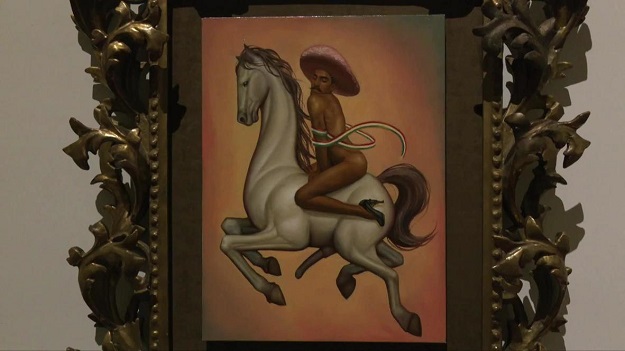A new portrait of Emiliano Zapata has caused a firestorm of outrage for its portrayal of the Mexican revolutionary hero striking a seductive pose – clad only in a pink sombrero and high heels.
Furious campesinos stormed one of the country’s most renowned art museums on Thursday to demand the removal of the painting, part of a new exhibition titled Zapata after Zapata that seeks to present alternative views of the Mexican revolution.
“This isn’t freedom of expression, it is debauchery! It’s degrading. They can’t exhibit our history that way,” fumed Antonio Medrano, a spokesman for the protesters. “They can’t permit this kind of mockery.”
The small painting by Fabián Cháirez depicts a naked Zapata, astride a white horse. His willowy frame is bound by a ribbon striped with the Mexican tricolor of red, white and green, while his lips pout under his distinctive curved moustache.
Press pictures of the painting provoked strong reactions in Mexico, where Zapata has maintained an unambiguously heroic reputation since the revolution of 1910 – when he called for “reform, freedom, justice and law”.
Some of Zapata’s heirs – with matching droopy moustaches – vowed to take legal action against the exhibition.
“We are not going to allow this,” said Jorge Zapata Gonzalez. “For us as relatives, this denigrates the figure of our general – depicting him as gay.”
Apocryphal tales of a gay romances involving Zapata have been published in recent decades, but historians say there is little evidence to support the stories.

Mexican politicians of all stripes have long tried to claim Zapata as their own – including the some of his supposed revolutionary allies, who later betrayed and killed him.
President Andrés Manuel López Obrador declared 2019 – the centennial of his death – as the “year of Zapata”, emblazoning the revolutionary leader’s familiar image of a bushy mustache, sombrero and bandolier on government letterhead and promotional materials.
“He’s the least controversial revolutionary strongman and the most ‘leftwing’ in the modern sense,’” said Harim B Gutiérrez, history professor at the Autonomous Metropolitan University.
But Zapata’s image is also the most malleable, and it has been appropriated by a host of social causes which may not have much to do with his original struggle to secure a better deal for landless peasants.
CLICK HERE FOR FULL ARTICLE ON YAHOO NEWS

